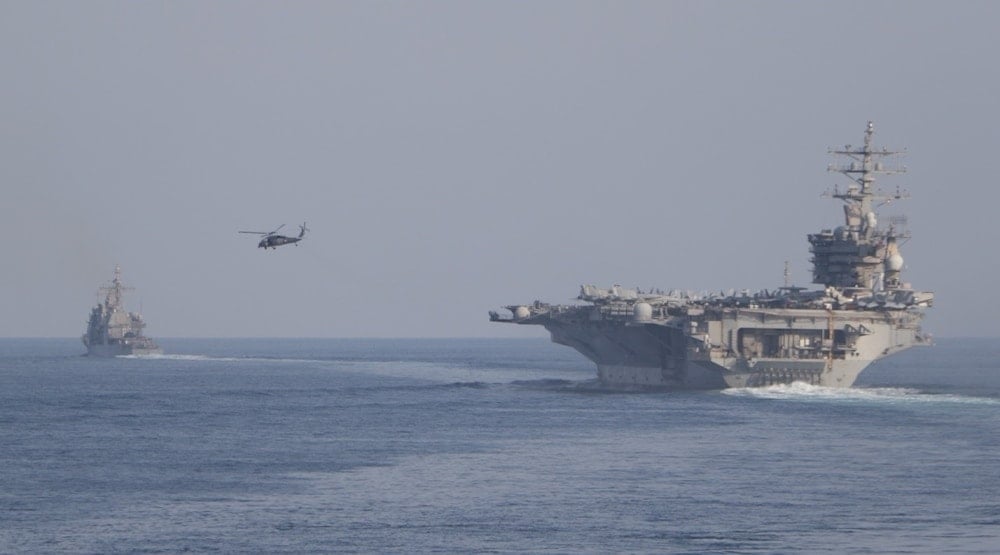Yemeni operations further expose US Navy fleet failures in Red Sea: RS
Dan Grazier believes most of the Dwight D. Eisenhower Carrier Strike Group carrier’s escort vessels have also had their deployments extended due to the US Navy's failure to reach its objectives.
-

The USS Dwight D. Eisenhower aircraft carrier after entering the Gulf waters crossing through the Hormuz Strait in a photo released on November 26, 2023 (US CENTCOM)
In late April, the USS Dwight D. Eisenhower, serving as the flagship of the Dwight D. Eisenhower Carrier Strike Group, along with the USS Gravely, left the Red Sea and entered the Eastern Mediterranean.
According to Dan Grazier, most of the carrier’s escort vessels have also had their deployments extended due to the US Navy's failure to reach its objectives.
Grazier wrote in Responsible Statecraft that one of the reasons was a lack of enough ships. He noted that the Red Sea threat is precisely the situation for which the Navy spent so much effort and money developing the Littoral Combat Ship, which was touted to the American public as a "networked, agile, stealthy surface combatant capable of defeating anti-access and asymmetric threats in the littorals."
The Yemeni Armed Forces' attacks in the Red Sea, he stated, is the "textbook definition" of an "asymmetric threat in a littoral region."
However, the "little crappy ships," as they have come to be called, are nowhere to be seen within the Red Sea. Rather, the Navy must retain a carrier strike group made up of Ticonderoga-class guided missile cruisers and Arleigh Burke-class destroyers on station for longer than expected in order to keep a key maritime choke point open.
Grazier explained that both the Littoral Combat Ship and the Zumwalt-class destroyer have been shipbuilding disasters during the last 20 years, which began following 9/11 as they quickly encountered problems.
The Zumwalt program had tremendous cost inflation, forcing Navy authorities to reduce the intended fleet size from 32 to 7, and then to the three that were ultimately completed. These three ships cost over $8 billion each and failed to achieve the claimed combat capability.
The Littoral Combat Ship program required $28 billion to develop a fleet of 35 ships, and, according to the Government Accountability Office, more than $60 billion will be needed to run the fleet throughout its estimated 25-year lifetime.
Like the Zumwalt, the LCS program's combat capability falls far short of expectations. The ships were planned to be modular, with sailors switching mission systems in port to suit varied missions. Engineers were unable to get the mission components to operate effectively, therefore the concept was abandoned.
Grazier explained how the USS Milwaukee broke down and other ships suffered from "saltwater corrosion, cracked hulls, and broken-down water jets," citing how Navy leaders began to retire ships decades earlier than they should have.
Navy chiefs are now hurrying to create the Constellation-class frigate to cover the capability vacuum left by the Littoral Combat Ship, he further explained.
Grazier concluded by warning that service commanders, civilian leaders, and members of Congress should remember this case the next time a military contractor shows them a bunch of attractive conceptual drawings and then claims transformational capabilities at rock-bottom pricing. The homesick sailors aboard the Ike now realize that if it sounds too good to be true, it most certainly is.
USS Dwight D Eisenhower leaves Red Sea after failing to stop Yemenis
USS Dwight D. Eisenhower and USS Gravely successfully transited the Suez Canal, after nearly four months stationed in the Red Sea, the Navy announced late last month.
During its stay in the Red Sea, the US battle group failed to halt Yemeni operations against maritime navigation linked to the Israeli regime as operations continued.
According to a news release from US Naval Forces Europe-Africa, the USS Dwight D. Eisenhower, serving as the flagship of the Dwight D. Eisenhower Carrier Strike Group, along with the USS Gravely, have now entered the Eastern Mediterranean. Their exact duration in the region remains undisclosed.
The deployment of the Ike Carrier Strike Group on October 13, followed by its navigation toward the Red Sea, was primarily focused on participating in Operation Prosperity Guardian.
However, the news release notably omitted the current locations of the USS Mason and USS Philippine Sea, the other components of the Ike CSG. USS Mason, akin to USS Gravely, has been actively engaged in defending the Israeli occupation.
The Yemeni Ansar Allah movement is working on reinforcing the country's reach toward the Indian Ocean, seeking to cut off the Israeli-affiliated ships from sailing on the Cape of Good Hope route or toward the Red Sea, Sayyed Abdul-Malik al-Houthi revealed last month.
The Yemeni front will remain open and the YAF operations in support of Palestine will continue, Sayyed al-Houthi stressed during a speech in which he addressed the latest regional developments.
The leader of the Ansar Allah movement emphasized that the expansion of the YAF's operations into the Indian Ocean was never taken into account by American, British, and Israeli authorities, or what Sayyed al-Houthi refers to as the "Triad of Evil."

 5 Min Read
5 Min Read








